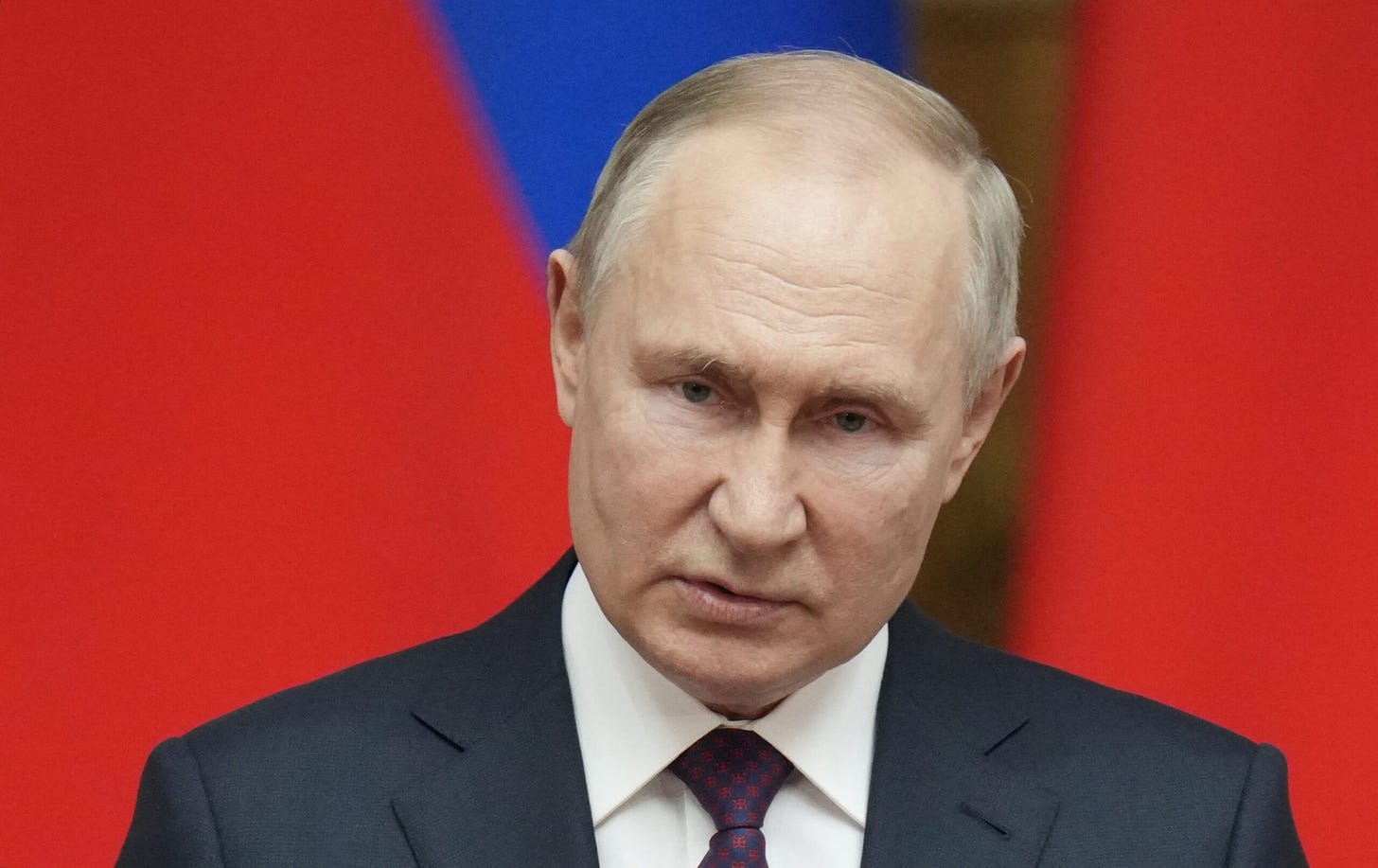
As I write, some evidence suggests that the first ripples of the long-awaited Ukrainian counteroffensive are finally in motion. For months, Russian forces have been pounding away at Ukrainian positions in the small city of Bakhmut, driving the defenders into a shrinking pocket. But now, the tables appear to be turning. Ukrainian troops are attacking Russian positions in Bakhmut on their flanks, driving them back. Retreating Russian soldiers, in an army of ill-fed and ill-equipped conscripts and convicts, are being executed by their own officers. Seizing Bakhmut has been a key Russian goal. It is supposedly also a Russian strong point and as of today Russia still controls 90 percent of the city. But if it begins to crumble, morale, already at a low point in Russia’s battered army, will further crumble with it.
How did Russia get into this fix? Why did Russian strongman Vladimir Putin launch a war that he cannot win and that has wrecked Russia’s military, costing it tens of thousands of lives and the destruction of much of its armored force? The story is told in Overreach, an engaging mixture of analysis and close-up reportage by the British journalist-historian Owen Matthews. In addition to a long career as a Moscow correspondent for Newsweek, Matthews has an intimate personal connection to Russia: His mother was born in 1934 in Kharkiv into a family that for two centuries served both the tsars and the Soviet Communists, and suffered dearly for their pains.
Matthews begins his analysis with a long view, recounting Ukraine’s history from its earliest days in the late ninth century as Kyivan Rus through to Russia’s seizure of Crimea and slices of eastern Ukraine in 2014. This is a necessary exercise given that the Russian strongman Vladimir Putin has himself delved into this ancient past to justify his military misadventure.
In 2021, Putin published a 7,000-word historical essay that was to serve, as Matthew reports, as the “ideological blueprint for war.” Putin wrote therein of the “great common misfortune and tragedy” that a “wall” had been erected between Russian and Ukraine, dividing “what is essentially the same historical and spiritual place.” Putin placed particular emphasis on the plight of ethnic Russians in Ukraine who, in his telling, were “being forced not only to deny their roots . . . but also to believe that Russia is their enemy.” Compulsory Ukrainian assimilation and “the formation of an ethnically pure Ukrainian state, aggressive towards Russia, is comparable in its consequences,” wrote Putin, “to the use of weapons of mass destruction against us.”
Comparable to the use of weapons of mass destruction against us? This is nothing if not paranoia, which is the flip side of extreme Russian nationalism. Both have a long and ugly history and Matthews explores their contemporary manifestations. He places particular emphasis on the role of key ideologues in shaping Russian public opinion while feeding Putin’s black view of Ukraine and the West.
Prominent among these ideologues is Aleksandr Dugin, the prophet of Russian nationalism. “We conservatives,” said Dugin a decade ago, “want a strong, solid state, want order and healthy family, positive values, the reinforcing of the importance of religion and the Church in society.” This formulation bears a striking resemblance to some strains of American conservatism—especially the “national conservatism” propounded by Yoram Hazony—although Dugin, now being celebrated in some quarters of American conservatism as a thinker from whom much can be learned, goes much further. In 1988 he founded the organization Pamyat (Memory), which in Matthews’s summary “posited that the holy, divinely ordained Russian Empire had been hijacked, undermined and ultimately destroyed by godless Bolshevik Jews.” For Russia, Dugin wrote in 1997 that he favors a “genuine, true, radically revolutionary and consistent, fascist fascism.”
Such ideas have been in circulation in Russia since the collapse of the Soviet Union, accompanied by exaggerated fears about NATO expansion eastward, the rise of supposed “Nazis” to power in Ukraine, the plight of millions of ethnic Russians subject to alleged Ukrainian persecution, and regrets about the collapse of the Soviet empire, famously characterized by Putin in 2005 as “the greatest geopolitical catastrophe of the century.” Indeed, as Matthews points out, “every contributing factor behind the Kremlin’s decision to invade Ukraine in 2022 had been in place for years, even decades.” The interesting question which thus arises is “not why Putin launched his full-scale invasion of Ukraine in 2022, but why he did not do it sooner?”
Matthews offers several answers: For one thing, by the beginning of this decade, the Russian efforts to meddle in Ukrainian affairs and constrain its political drift westward had ended in failure. Matthews highlights as a decisive turning point Ukrainian president Volodymyr Zelensksy’s decision to have Ukraine take part in NATO military exercises in March 2021. By the close of that year “the jeopardy from Western influence in Ukraine,” as seen from the Kremlin, “had become too threatening to ignore.”
At the same point in time, Russia’s economic position seemed particularly favorable. Not only did Europe depend heavily on Russian energy imports, but the country had accumulated a strategic reserve of $650 billion. The former, it was believed, would serve as a damper on Western support for Ukraine, while the latter was sufficient to prevail in the teeth of even draconian sanctions.
Most important of all, argues Matthews, was the opening of a window, or several windows: “A confluence of Western weakness in the aftermath of the humiliating withdrawal from Afghanistan, the retirement of Angela Merkel as Europe’s senior statesperson, the electoral weakness of Zelensky and a revamped Russian army seemed to present a once-in-a lifetime opportunity.”
But it was all a mirage. Putin’s “fundamental error was to imagine that Russian-speaking Ukrainians naturally considered themselves ethnically and politically Russian.” This proved false and “millions of Russian-speaking Ukrainians fled from Moscow’s forces, and tens of thousands volunteered to fight against their would be ‘liberators.’”
Misled about the true state of affairs in Ukraine, Putin also badly underestimated the Ukrainian military. By 2022, Ukrainian officers and soldiers had already for some time been training in staff colleges in the United States and other NATO countries and taking part in NATO exercises. In the more than half-decade of fighting since the Russian incursions of 2014, the Ukrainian military has been in the midst of a transformation from a top-down Soviet style force into a modern Western army where daring and initiative count.
Putin also badly underestimated the reaction of the West. In 2022, the United States alone provided $55 billion in military aid to Ukraine, an amount almost equivalent to Russia’s entire annual military budget. Highly lethal arms, like anti-tank Javelin missiles, had a decisive effect on repelling Russia’s initial invasion. Longer range systems, most notably, the HIMARS rocket system, have been wearing down Russia’s capacity to concentrate forces and mobilize for offensive action. European contributions to Ukraine’s military prowess have also been substantial.
Perhaps most egregiously, Putin overestimated the Russian military into which so much money had been poured over the previous decade. Much of it had been looted by its intended beneficiaries. Matthews draws on an account offered by a professional soldier, Pavel Filatyev. On joining the 56th Guards Air Assault Regiment, he found
no beds in his barracks, and often no power or water. A pack of wild dogs roamed through the buildings. Nor was there enough food, just stale bread and “soup” that was raw potatoes in water. On paper his unit had 500 soldiers, but it was really just 300. He had to buy his own winter uniform after being given summer clothes and boots in the wrong size. His rifle was rusty and jammed after a few shots, and he was deployed to Ukraine without a flak jacket, which he assumed had been stolen and sold off by his officers.
And this was supposedly an elite unit. The Russian army, wrote Filatyev, “is a madhouse and everything is for show.” Filatyev deserted and made his way to France. Though enormous in quantity of men and materiel, the Russian army has become a hollow shell.
Matthews is an astute and seasoned observer who, through close familiarity, enables us to see the conflict through Russian eyes. His treatment of Russian nationalism shows the inextricable links between ethnonationalism and intolerance and aggression. Here there are lessons for the United States as we deal with our own variants of the malady. For our own homegrown brand of national conservatism bleeds into extremism in much the same way, though not quite as virulently, at least not yet. A case in point is the open racism, and—not accidentally—support for Russia against Ukraine, of Tucker Carlson, who keynoted Hazony’s first national conservatism conference.
Also of particular interest is Matthews’s discussion of the place of NATO in Putin’s thinking over the two decades preceding the outbreak of war. Did NATO enlargement, and in particular growing NATO engagement with Ukraine, provoke the Russian invasion?
Matthews finds the answer in a tragic dilemma. Every aggressive move by Putin—in Georgia in 2008, in Crimea in 2014, in Syria in 2015—only served to alarm NATO members, persuading them of the need to strengthen the alliance. And every such aggressive move only increased the desire of Russia’s menaced neighbors to join it. “NATO believed,” writes Matthews, “that shows of military solidarity would discourage Russian aggression.” But to Moscow, “it was precisely such symbolic shows of military engagement that were so provocative.” The two sides were “locked in an escalating dialogue of the deaf” that brought them into collision.
This is a discomfiting conclusion. But the blame for Russia’s invasion of Ukraine cannot be laid on NATO’s doorstep. Indeed, it is Putin’s willingness to engage in naked aggression against Ukraine, based on nothing more than an ethnonationalist fantasy, that vindicates both the necessity of the alliance and the desire of Russia’s understandably terrified neighbors to join it. To know thine enemy is not to excuse or justify his behavior.





